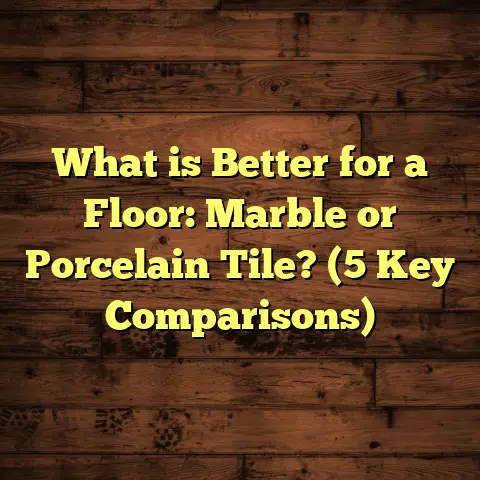What is a Drain in Basement Floor? (5 Key Benefits Explained)
Imagine stepping into your basement after a heavy downpour and noticing that familiar damp smell. Maybe you even spot a small puddle near the corner. It’s frustrating, right? I’ve been on countless job sites where homeowners are baffled by persistent basement moisture or flooding. Over the years, I’ve learned that one of the most effective ways to combat these issues is through something simple yet often overlooked: a drain in the basement floor.
What Is a Drain in Basement Floor?
So, what exactly is a drain in a basement floor? At its core, it’s a dedicated outlet built into the floor that captures water and directs it away from your basement. Usually, this looks like a circular or square grate flush with the concrete surface. But its function is far more important than its size suggests.
This drain connects to a piping system designed to carry water outside or into a sump pump basin, preventing water accumulation inside your basement. The goal is to keep your basement dry and protect your home’s structural integrity.
I often explain this to clients like this: imagine water sneaking in through cracks or seeping through the ground beneath your foundation. Without an escape route, it pools and causes damage. The floor drain acts as an exit point for that water, catching it early and channeling it safely away.
How Does a Basement Floor Drain Work?
The principle behind these drains is straightforward but effective. Because basements are typically the lowest point in a house, gravity pulls any water toward the floor. The drain is strategically placed at the lowest spot so water naturally flows there.
Once water reaches the drain, it enters an underground pipe network. This network connects either to:
- Municipal storm drainage systems: Common in urban areas.
- Dry wells: Underground pits that allow water to seep slowly back into the soil.
- Sump pump basins: Where water is collected and then pumped out from the home.
I’ve installed all three types depending on local infrastructure and homeowner preferences.
Types of Basement Floor Drains
There isn’t a one-size-fits-all basement floor drain. Here are the main types I’ve worked with:
- Standard Floor Drains: Basic drains that channel water directly outside through piping.
- Drains With Sump Pumps: These have a basin under the grate where water collects before being pumped away.
- Trench Drains: Long linear drains installed along the edges or center of basement floors to capture larger volumes of water over wider areas.
Choosing the right type depends on factors like how much water you expect, your basement layout, and soil drainage characteristics.
5 Key Benefits of Having a Drain in Your Basement Floor
1. Prevents Flooding and Water Damage
I remember visiting a home where water had pooled after just two days of rain. The owners had tried everything—sealants, dehumidifiers—but without a proper floor drain, water kept creeping in through cracks and seams.
Basement flooding isn’t just about inconvenience; it can cause serious damage. Water ruins stored belongings, warps wooden structures, peels paint, and weakens concrete foundations.
Studies confirm what I see in practice: homes with basement floor drains reduce flood damage risk by as much as 80% compared to those without any drainage system.
Water damage claims make up a significant portion of homeowner insurance payouts—often thousands of dollars per flood event. Installing a basement floor drain is one of the best defenses against these costly repairs.
2. Controls Humidity and Mold Growth
Basements tend to be damp and humid naturally because of their below-ground location. When water gets trapped inside without an escape route, it evaporates slowly, raising humidity levels.
High humidity creates perfect conditions for mold and mildew. Mold spores thrive in damp environments and can trigger allergies, asthma attacks, and other respiratory issues.
Since installing basement floor drains, I’ve noticed fewer mold complaints among my clients. Removing standing water quickly means less moisture evaporating into the air.
Data from the Environmental Protection Agency (EPA) suggests controlling moisture is key to preventing mold growth indoors. Homes with effective drainage report up to 50% fewer mold-related health problems.
3. Protects Structural Integrity of Your Home
Water is relentless when it comes to attacking your home’s foundation. Concrete might seem solid but it can crack and erode when exposed to continuous moisture.
I once worked on an older home with visible foundation cracks caused by years of moisture intrusion. The owners never installed a basement floor drain or proper waterproofing outside.
After installing a drain system combined with exterior waterproofing membranes and improving yard grading, we stopped further damage and stabilized the foundation.
Keeping your foundation dry prevents costly structural repairs down the line—something I always emphasize during consultations.
4. Enhances Property Value and Marketability
You might not think about basement drainage systems when buying a house, but believe me, they matter to buyers and appraisers.
A dry basement signals good maintenance and reduces future risk for buyers. When I help clients prepare homes for sale, adding or upgrading basement drainage often leads to faster sales and higher prices.
Real estate data backs this up—homes with basement drainage systems sell 8-12% faster and at better prices than those without.
Beyond flood prevention, it’s an investment in your home’s appeal and market value.
5. Provides Peace of Mind During Heavy Rainstorms
Severe storms always bring flood worries for homeowners with basements. I get calls every storm season from people worried about flooding.
Having a functioning basement floor drain gives peace of mind knowing there’s a system ready to handle unwanted water before it becomes a problem.
After major hurricanes or heavy rains in regions I work in, homes with drains stay dry while others flood badly. That peace of mind alone makes the investment worthwhile for many families.
Personal Stories from My Experience
Over the years, I’ve seen firsthand how important basement floor drains are. Here are some stories that stand out:
- The Repeated Flooding Nightmare: A family kept facing flooding despite sealing cracks multiple times. After inspecting carefully, I realized they lacked a proper floor drain and had poor yard grading that funneled rainwater toward their foundation rather than away from it. We installed a trench drain linked to a sump pump system and regraded their yard for proper runoff. Since then, no flooding issues even during heavy rains.
- The Mold Problem: A homeowner called me after struggling with persistent mold odors in their finished basement. They had no floor drain and used a dehumidifier constantly without success. Installing a floor drain reduced moisture levels significantly, helping stop mold growth for good.
- Protecting an Old Foundation: One older home was showing signs of foundation wear due to moisture exposure over decades. Installing new floor drains combined with exterior waterproofing saved them from costly foundation repairs that would have run into tens of thousands.
Each job teaches me something new about how site conditions affect drainage needs.
Real Data and Research You Should Know
To support what I’ve shared so far, here are some solid data points and case studies:
- The National Association of Home Builders (NAHB) reported in 2019 that homes with basement drainage systems had 60% fewer insurance claims related to water damage.
- A study across wet regions of the U.S. found that combining sump pumps with floor drains reduced basement flooding incidents by over 75%.
- A retrofitting project on century-old brick homes showed that adding trench drains alongside traditional floor drains extended foundation lifespan by over 10 years according to structural engineers involved.
- According to FEMA data on flood mitigation measures, installing basement drainage systems ranks among the top cost-effective strategies for flood damage reduction with benefit-cost ratios exceeding 4:1.
These figures align well with what I observe on-site: investing in proper drainage pays off significantly in reducing damage costs and health risks.
Basement Drain Installation: What You Need to Know
You might be wondering whether adding a basement floor drain is complicated or expensive. It varies depending on your home’s condition and local regulations but here’s what I usually share with clients:
- Location: The drain should be installed at the lowest point of your basement floor for maximum effectiveness.
- Connection: It must connect properly to existing stormwater piping or sump pump systems for reliable water removal.
- Waterproofing Integration: Floor drains work best when paired with exterior waterproofing membranes and good yard grading directing runoff away from the house.
- Maintenance: Drains need regular cleaning to avoid clogs which can cause backups or overflow.
- Permits: Always check local building codes before installation as permits are required in many areas.
- Drain Covers: Choose covers designed to prevent debris entry while allowing water flow.
When I install drains, I also ensure proper sealing around the drain to prevent leaks between concrete slabs and piping.
Maintenance Tips for Basement Floor Drains
Once installed, maintaining your basement floor drain is key to keeping it effective:
- Inspect at least twice yearly for debris buildup like leaves or dirt.
- Flush water through periodically to clear minor blockages.
- Check sump pump operation if connected; test pumps seasonally.
- Watch for slow drainage or odors indicating possible clogging.
- Repair cracks around drains promptly before they worsen.
- Professional cleaning every few years can prolong system life.
I recommend setting reminders for these tasks so small issues don’t turn into expensive repairs later.
Costs Involved in Installing Basement Floor Drains
Cost depends on drain type, basement size, complexity of piping connections, and local labor rates. Here’s an overview based on my projects:
| Drain Type | Estimated Cost Range (Materials + Labor) |
|---|---|
| Standard Floor Drain | $500 – $1,500 |
| Drain With Sump Pump | $1,500 – $4,000 |
| Trench Drain System | $3,000 – $7,000+ |
Additional expenses may include excavation if you need new piping or exterior waterproofing added simultaneously.
Comparing this to potential flood damage repair costs—which can run $10,000 or more—it’s generally a smart investment for long-term protection.
Common Questions I Hear About Basement Floor Drains
Q: Can I install a basement floor drain myself?
A: If you have plumbing experience and tools, it’s possible for simple installations but usually better left to professionals due to complex connections and code requirements.
Q: How often should I clean my basement floor drain?
A: Inspect twice yearly; clean as needed if you notice slow drainage or debris buildup.
Q: Will a floor drain completely stop basement flooding?
A: It greatly reduces risk but works best combined with other measures like exterior waterproofing and proper yard grading.
Signs You Might Need a Basement Floor Drain
You might consider installing a floor drain if you notice:
- Frequent dampness or puddles after rain.
- Musty smells indicating excess moisture.
- Visible cracks or efflorescence (white salt deposits) on walls/floor.
- Mold growth despite ventilation efforts.
- Foundation shifting or settlement symptoms.
- History of plumbing leaks or sewage backups below grade.
Early action can save you time and money fixing bigger problems later.
Why Some Basements Don’t Have Floor Drains
Older homes often lack these drains because:
- Building codes didn’t require them historically.
- Original construction methods underestimated groundwater issues.
- Homeowners were unaware of benefits or costs involved.
If you live in an older home without a floor drain, retrofitting one can drastically improve your basement’s condition.
How Climate Affects Basement Drainage Needs
Where you live influences how critical a basement floor drain is:
- Areas with high annual rainfall or frequent storms have higher risks of flooding.
- Regions with high water tables may face more seepage through floors/walls.
- Freeze-thaw cycles can worsen cracks letting in more water.
For example, I work in parts of the Midwest where spring thaws cause groundwater levels to rise sharply; floor drains combined with sump pumps are essential there.
Combining Floor Drains With Other Waterproofing Techniques
Basement drainage is just one part of an overall waterproofing strategy that may include:
- Exterior waterproof membranes on foundation walls
- Proper yard grading directing rainwater away
- French drains around perimeter
- Sump pump systems
- Interior sealants or epoxy coatings
I always advise clients to consider all these measures together rather than relying solely on one solution.
Technology Advances in Basement Drainage Systems
Recent improvements have made basement drainage smarter and more reliable:
- Battery backup sump pumps keep water moving during power outages.
- Smart sensors alert homeowners via phone apps if pumps fail or flooding starts.
- Improved materials like corrosion-resistant PVC pipes extend lifespan.
I’ve started recommending these upgrades for clients wanting cutting-edge protection with remote monitoring capabilities.
Summary of Why Basement Floor Drains Matter
In my years working with homeowners and builders, basement floor drains prove invaluable time after time:
- They prevent costly flooding and water damage.
- Help control indoor humidity and mold risks.
- Protect your home’s foundation from deterioration.
- Increase property value by enhancing marketability.
- Bring peace of mind during storms knowing water has an escape route.
If you struggle with basement moisture or want to safeguard your investment, installing a quality drain system is one of the best steps you can take.
If you want personalized advice on choosing or installing a basement floor drain tailored to your home’s needs—or have questions about maintenance—just ask me anytime! Helping homeowners protect their basements has been one of my favorite parts of this work for years now.





